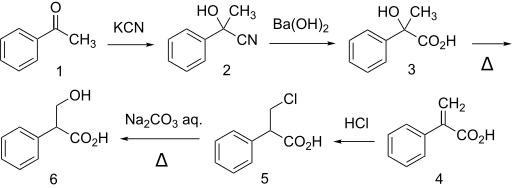 | |
| Names | |
|---|---|
| Preferred IUPAC name 3-Hydroxy-2-phenylpropanoic acid | |
| Other names 2-Phenylhydracrylic acid; Tropate | |
| Identifiers | |
3D model (JSmol) | |
| ChEBI | |
| ChemSpider | |
| ECHA InfoCard | 100.008.201 |
| EC Number |
|
| KEGG | |
| MeSH | C011377 |
PubChem CID | |
| UNII | |
CompTox Dashboard (EPA) | |
| |
| |
| Properties | |
| C9H10O3 | |
| Molar mass | 166.176 g·mol−1 |
| Melting point | 116 °C (241 °F; 389 K) |
Except where otherwise noted, data are given for materials in their standard state (at 25 °C [77 °F], 100 kPa). | |
Tropic acid is a chemical with IUPAC name 3-hydroxy-2-phenylpropanoic acid and condensed structural formula HOCH2CHPhCOOH. It is a laboratory reagent used in the chemical synthesis of atropine and hyoscyamine. Tropic acid is a chiral substance, existing as either a racemic mixture or as a single enantiomer.
